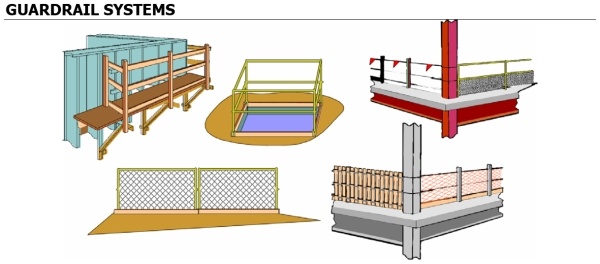
A synopsis of OSHA’s Fall Protection Standards (OSHA standard 29 CFR 1926.501 through 503).
Fall protection is generally thought of as:
- Guardrail systems
- Safety net systems
- Personal fall arrest systems
- Positioning device systems, and/or
- Warning line systems
The standard:
- Covers most construction workers except persons inspecting, assessing, or investigating the workplace conditions prior to the start of work or after the completion of work.
- Identifies areas or activities where fall protection is needed.
- Sets a uniform threshold height of six (6) feet
- Allows employers to select fall protection measures that are best suited for the work being performed.
Guardrail requirements:
- Top edge height of top rails must be 42 inches (+/- 3 inches) above working/walking level & support 200 lb. force (use at least 2″x4″ lumber for wood top rails).
- Mid rails, screens, mesh, intermediate vertical members, or equivalent emmbers shall be installed mid-way between the top rail and working/walking level & support 150 lb. force (use at least 1″x6″ lumber for wood mid rails).
- Toe boards shall be 3.5 inches high & support 50 lb. force.
- Posts shall be no more than 8 feet apart (use 2″x4″ lumber for wood posts).

Fall Arrest Systems: Harness, Lanyard, Connectors & Anchors
- Shall be inspected prior to each use.
- Attachment point to body shall be in the center of the wearer’s back.
- Limit fall to six (6) feet and prevent contact with lower levels.
- Limit maximum deceleration distance to 3.5 feet.
- D-rings & snaphooks must have minimum tensile strength of 5,000 pounds.
- Lanyards & lifelines must have minimum breaking strength of 5,000 pounds.
- Self retracting lifelines & lanyards that limit fall distance to 2 feet or less must have minimum tensile strength of 3,000 pounds applied to the device with lifeline fully extended. Greater than 2 feet the minimum tensile strength must be 5,000 pounds.
- Anchorages must be capable of supporting at least 5,000 pounds.
- Body belts & other positioning device systems are not a part of the personal fall arrest system.
Positioning Device Systems
- Should limit falls to no more than 2 feet.
- Secured to an anchor capable of supporting a potential impact of 2x the impact load of the employees fall or 3,000 pounds (whichever is less).
- Requirements for d-rings, snaphooks & other connectors must meet those of personal fall arrest systems.
Covers
- On roadways, capable of support 2x the maximum axle load of the largest vehicle expected to impact the cover.
- Capable of supporting 2x the weight of employees and equipment.
- Must be secured when installed.
- Color coded and marked “HOLE” or “COVER”.
Alternative Measures to Personal Fall Protection
Three alternatives include warning line systems, controlled access zones, and safety monitoring systems. The employer must prove conventional fall protection is not feasible or would cause a greater hazard & develop a written fall protection program. Does not include roofing, overhand bricklaying or residential construction practices.
Warning line systems
- Only allowed on low-sloped roofs (less than or equal to 4×12 pitch).
- Must be erected around all sides and not less than six (6) feet from the roof edge.
- Flagged at least every 6 feet with high visibility material.
- Rigged and supported so the line is between 34 inches and 39 inches.
- Stanchions must be able to support a 16 pound horizontal force.
- Warning line must be able to support a 500 pound minimum tensile strength.
- Must be used in conjunction with another fall protection system.
Controlled access zones
- Erected between 6 -25 feet from the unprotected/leading edge.
- Control lines must consist of ropes, wires, tapes, or equivalent.
- Flagged at least every 6 feet with high visibility material.
- Rigged and supported so the line is between 39 inches and 45 inches.
- Capable of support a minimum 200 lb. stress.
- Extend along the entire length of the unprotected or leading edge and connected to each side of the guardrail system or wall.
Safety Monitoring Systems
- Competent person is responsible for recognizing and warning employees of fall hazards.
- Competent person must be on same working level.
- Competent person must be able to communicate orally with workers.
- Competent person must not have any other duties which distract from the monitoring duties.
Information provided in Colorado State University’s 6 page document entitled “Fall Protection Guidelines in Construction” and can be downloaded HERE:(
 MaterialsHandlingPPT.ppt (4.2 MiB, 2,074 hits)
MaterialsHandlingPPT.ppt (4.2 MiB, 2,074 hits)
